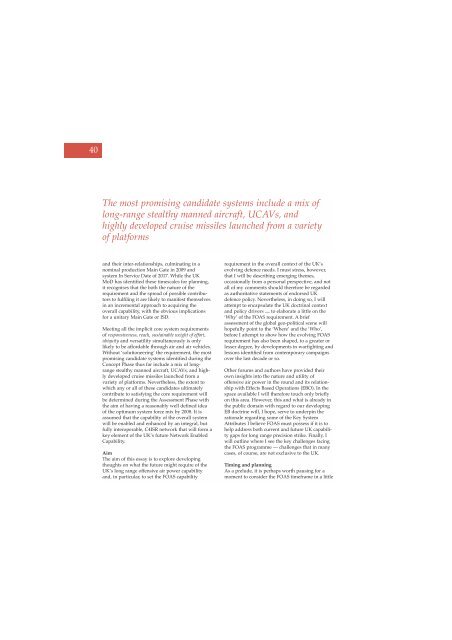Volume 6 No 4 - Royal Air Force Centre for Air Power Studies
Volume 6 No 4 - Royal Air Force Centre for Air Power Studies
Volume 6 No 4 - Royal Air Force Centre for Air Power Studies
Create successful ePaper yourself
Turn your PDF publications into a flip-book with our unique Google optimized e-Paper software.
40<br />
The most promising candidate systems include a mix of<br />
long-range stealthy manned aircraft, UCAVs, and<br />
highly developed cruise missiles launched from a variety<br />
of plat<strong>for</strong>ms<br />
and their inter-relationships, culminating in a<br />
nominal production Main Gate in 2009 and<br />
system In Service Date of 2017. While the UK<br />
MoD has identified these timescales <strong>for</strong> planning,<br />
it recognises that the both the nature of the<br />
requirement and the spread of possible contributors<br />
to fulfiling it are likely to manifest themselves<br />
in an incremental approach to acquiring the<br />
overall capability, with the obvious implications<br />
<strong>for</strong> a unitary Main Gate or ISD.<br />
Meeting all the implicit core system requirements<br />
of responsiveness, reach, sustainable weight of ef<strong>for</strong>t,<br />
ubiquity and versatility simultaneously is only<br />
likely to be af<strong>for</strong>dable through air and air vehicles.<br />
Without ‘solutioneering’ the requirement, the most<br />
promising candidate systems identified during the<br />
Concept Phase thus far include a mix of longrange<br />
stealthy manned aircraft, UCAVs, and highly<br />
developed cruise missiles launched from a<br />
variety of plat<strong>for</strong>ms. Nevertheless, the extent to<br />
which any or all of these candidates ultimately<br />
contribute to satisfying the core requirement will<br />
be determined during the Assessment Phase with<br />
the aim of having a reasonably well defined idea<br />
of the optimum system <strong>for</strong>ce mix by 2008. It is<br />
assumed that the capability of the overall system<br />
will be enabled and enhanced by an integral, but<br />
fully interoperable, C4ISR network that will <strong>for</strong>m a<br />
key element of the UK’s future Network Enabled<br />
Capability.<br />
Aim<br />
The aim of this essay is to explore developing<br />
thoughts on what the future might require of the<br />
UK’s long range offensive air power capability<br />
and, in particular, to set the FOAS capability<br />
requirement in the overall context of the UK’s<br />
evolving defence needs. I must stress, however,<br />
that I will be describing emerging themes,<br />
occasionally from a personal perspective, and not<br />
all of my comments should there<strong>for</strong>e be regarded<br />
as authoritative statements of endorsed UK<br />
defence policy. Nevertheless, in doing so, I will<br />
attempt to encapsulate the UK doctrinal context<br />
and policy drivers — to elaborate a little on the<br />
‘Why’ of the FOAS requirement. A brief<br />
assessment of the global geo-political scene will<br />
hopefully point to the ‘Where’ and the ‘Who’,<br />
be<strong>for</strong>e I attempt to show how the evolving FOAS<br />
requirement has also been shaped, to a greater or<br />
lesser degree, by developments in warfighting and<br />
lessons identified from contemporary campaigns<br />
over the last decade or so.<br />
Other <strong>for</strong>ums and authors have provided their<br />
own insights into the nature and utility of<br />
offensive air power in the round and its relationship<br />
with Effects Based Operations (EBO). In the<br />
space available I will there<strong>for</strong>e touch only briefly<br />
on this area. However, this and what is already in<br />
the public domain with regard to our developing<br />
EB doctrine will, I hope, serve to underpin the<br />
rationale regarding some of the Key System<br />
Attributes I believe FOAS must possess if it is to<br />
help address both current and future UK capability<br />
gaps <strong>for</strong> long range precision strike. Finally, I<br />
will outline where I see the key challenges facing<br />
the FOAS programme — challenges that in many<br />
cases, of course, are not exclusive to the UK.<br />
Timing and planning<br />
As a prelude, it is perhaps worth pausing <strong>for</strong> a<br />
moment to consider the FOAS timeframe in a little
















